History of the Treasury
Hamilton and the Establishment of the Department of the Treasury
The Development of the Department
Revolutionary Period
The history of the Department of the Treasury began in the turmoil of the American Revolution, when the Continental Congress at Philadelphia deliberated the crucial issue of financing a war of independence against Great Britain. The Congress had no power to levy and collect taxes, nor was there a tangible basis for securing funds from foreign investors or governments. The delegates resolved to issue paper money in the form of bills of credit, promising redemption in coin on faith in the revolutionary cause. On June 22, 1775 -- only a few days after the Battle of Bunker Hill, Congress issued $2 million in bills; on July 25, 28 citizens of Philadelphia were employed by the Congress to sign and number the currency.
On July 29, 1775, the Second Continental Congress assigned the responsibility for the administration of the revolutionary government's finances to Joint Continental Treasurers, George Clymer and Michael Hillegas. The Congress stipulated that each of the colonies contribute to the Continental government's funds.
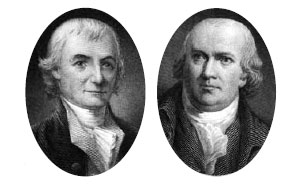
(Left) Michael Hillegas, first Treasurer of the United States, 1775-89. (Right) Robert Morris, Superintendent of Finance, 1781-84. (Bureau of Engraving and Printing) Learn about the major duties and functions of each Treasury Department Office and Bureau.
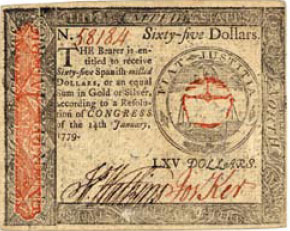
This $65 Continental note was issued January 14, 1779. The Revolutionary money was printed in various denominations and signed by hand. (University Libraries of Notre Dame)
To ensure proper and efficient handling of the growing national debt in the face of weak economic and political ties between the colonies, the Congress, on February 17, 1776, designated a committee of five to superintend the Treasury, settle the accounts, and report periodically to the Congress. On April 1, a Treasury Office of Accounts, consisting of an Auditor General and clerks, was established to facilitate the settlement of claims and to keep the public accounts for the government of the United Colonies. With the signing of the Declaration of Independence on July 4, 1776, the new-born republic as a sovereign nation was able to secure loans from abroad.
Despite the infusion of foreign and domestic loans to pay for a war of independence, the United Colonies were unable to establish a well-organized agency for financial administration. Michael Hillegas was first called Treasurer of the United States on May 14, 1777. The Treasury Office was reorganized three times between 1778 and 1781. The $241.5 million of paper Continental Dollars devalued rapidly. By May 1781, the dollar collapsed at a rate of from 500 to 1000 to 1 against hard currency. Protests against the worthless money swept the colonies and angry Americans coined the expression not worth a Continental.
Robert Morris was designated Superintendent of Finance in 1781 and restored stability to the nation's finances. Morris, a wealthy colonial merchant, was nicknamed "the Financier" because of his reputation for procuring funds or goods on a moment's notice. His staff included a Comptroller, a Treasurer, a Register, and auditors, who managed the country's finances through 1784, when Morris resigned because of ill health. The Treasury Board of three Commissioners continued to oversee the finances of the confederation of former colonies until September 1789.
Hamilton and the Establishment of the Department of the Treasury
The First Congress of the United States was called to convene in New York on March 4, 1789, marking the beginning of government under the Constitution. On September 2, 1789, Congress created a permanent institution for the management of government finances:
Be it enacted by the Senate and House of Representatives of the United States of America in Congress assembled, That there shall be a Department of Treasury, in which shall be the following officers, namely: a Secretary of the Treasury, to be deemed head of the department; a Comptroller, an Auditor, a Treasurer, a Register, and an Assistant to the Secretary of the Treasury, which assistant shall be appointed by the said Secretary.
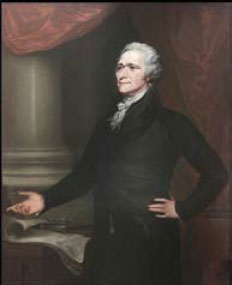
Alexander Hamilton served as the first Secretary of the Treasury from 1789 to 1795. One of the most brilliant statesmen of the early American republic, he was killed in a duel in 1804. (Treasury Collection)
Alexander Hamilton took the oath of office as the first Secretary of the Treasury on September 11, 1789. Hamilton had served as George Washington's aide-de-camp during the Revolution, and was of great importance in the ratification of the Constitution. Because of his financial and managerial acumen, Hamilton was a logical choice for solving the problem of the new nation's heavy war debt.
Hamilton's first official act was to submit a report to Congress in which he laid the foundation for the nation's financial health. To the surprise of many legislators, he insisted upon federal assumption and dollar-for-dollar repayment of the countrys war debt of $75 million in order to revitalize the public credit: "[T]he debt of the United States' was the price of liberty. The faith of America has been repeatedly pledged for it, and with solemnities that give peculiar force to the obligation." Hamilton foresaw the development of industry and trade in the United States, and suggested that government revenues be based upon customs duties. His sound financial policies also inspired investment in the Bank of the United States, which acted as the government's fiscal agent.
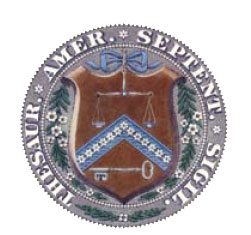
The original Seal of the Department of the Treasury, designed in 1778. The Latin inscription is an abbreviation for the phrase Thesauri Americae Septentrionalis Sigillum, which means "The Seal of the Treasury of North America." The seal was simplified in 1968 and now bears the words "The Department of the Treasury" and the date of the Department's establishment, 1789. (Department of the Treasury)
The Treasury Building
In the first years of the American republic's existence, the government was quartered in Philadelphia until the new capital city, as authorized in the Constitution, was built on the banks of the Potomac River. In 1800, the government moved to Washington, D.C., and the Department of the Treasury moved into a porticoed Georgian-style building designed by an English architect, George Hadfield. This structure was burned by the British in 1814, but was rebuilt by White House architect James Hoban. This building was identical to three others located on lots adjacent to the White House, each housing one of the four original departments of the U.S. Government: State, War, Treasury and Navy. The Treasury Building, to the southeast of the White House, was burned by arsonists in 1833 with only the fireproof wing left standing.
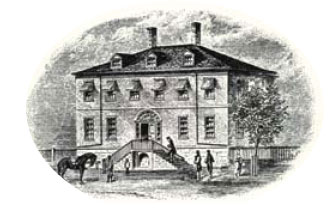
View of the east entrance of the first Treasury Building in Washington, 1804. The principal entrance of the building faced south. It was burned to the ground by the British in 1814 and was replaced by an identical structure which was destroyed by fire in 1833. (Department of the Treasury)
The present Treasury Building is a magnificent granite structure in the Greek Revival style; it was built over a period of 33 years between 1836 and 1869. The east and center wings, designed by Robert Mills, architect of the Washington Monument and the Patent Office Building, comprise the first part of the building constructed from 1836 to 1842. The most architecturally impressive feature of the Mills design is the east front colonnade running the length of the building. Each of the 30 columns is 36 feet tall and is carved out of a single block of granite. The interior design of the east and center wings is classically austere, in keeping with the Greek Revival style.

East front of the Main Treasury circa 1865. The 336-foot long colonnade was rebuilt with granite in 1908. On the right stands the old State Department building, which was razed in 1866 to make room for the north wing of Main Treasury. (Treasury Collection)
Later additions were made to the original wings, beginning with the construction of the south wing from 1855 to 1860 and the west wing from 1855 to 1864. The preliminary design of the wings was provided by Thomas Ustick Walter, architect of the dome of the U.S. Capitol, but architects Ammi B. Young and Isaiah Rogers refined the plans, designed the interior details, and supervised construction. While the exterior of the building was executed along the lines of the original Mills wings, the interiors of the later wings reflect changes in both building technology and aesthetic tastes. Iron columns and beams reinforced the building's brick vaults; the architectural detailing became much more ornate, following mid-nineteenth century fashion.
The final addition to the Treasury Building was the north wing, built from 1867 to 1869. Its architect was Alfred B. Mullett, who subsequently designed the State, War, and Navy Building (now the Dwight D. Eisenhower Building) on the other side of the White House.
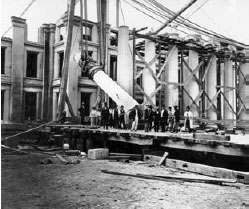
Solid granite columns are hoisted into place on the north portico of the Treasury Building, September 16, 1867. (National Archives)
Similar in construction and decor to the south and west wings, the north wing is unique as the site of the Cash Room -- a two-story marble hall in which the daily financial business of the U.S. Government could be transacted. The room was opened in 1869 as the site of President Ulysses S. Grants Inaugural Reception.

The Inaugural Reception of President Ulysses S. Grant took place in the Treasury Cash Room on March 4, 1869. The event was so crowded that guests had to wait two hours to retrieve their coats. (Treasury Collection)
The Treasury Building is the oldest departmental building in Washington and has had a great impact on the design of other government buildings. At the time of its completion, it was one of the largest office buildings in the world. It served as a barracks for soldiers during the Civil War and as the temporary White House for President Andrew Johnson following the assassination of President Lincoln in 1865.
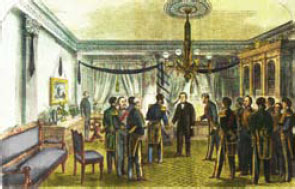
Following the assassination of President Lincoln in 1865, Andrew Johnson used the Secretary's reception room as a temporary office before moving into the White House. (Treasury Collection)
The Development of the Department
Throughout the decades of American history, the Department of the Treasury has been a dynamic aspect of the government's service to the people, expanding and developing to accommodate the nation's needs. While the fiscal and collection functions have remained substantially constant for over two centuries, other incidental operations have varied greatly. Most of the functions assigned to Treasury by the Act of 1789 are still carried out by the Department of the Treasury, although the functions of the Comptroller have been assumed by the Comptroller General of the U.S. Government Accountability Office.

The interior of the Cash Room where government checks could be cashed as recently as 1976. The walls are made of seven varieties of American and imported marble. (Department of the Treasury)
Many functions of the Federal Government, regardless of fiscal significance, were first placed under the jurisdiction of Treasury; other agencies or executive departments have since been created to administer some of these activities. The Postal Service, for example, was supervised by Treasury until 1829; the General Land Office, which was the nucleus of the Department of the Interior, was part of Treasury from 1812 to 1849. Operations associated with business were Treasury activities until the creation of the Department of Commerce and Labor in 1903; and the functions of the Office of the Supervising Architect of the Treasury were eventually established within the General Services Administration in 1949. The oldest seagoing armed service in the United States, the Coast Guard, remained in the Department of the Treasury until its transfer to the Department of Transportation in 1967. Other marine interests were administered by Treasury: the Coast Survey, the Lighthouse Service, and the Marine Hospital Service, from which the Public Health Service, and ultimately, the Department of Health and Human Services grew. The Bureau of Narcotics was part of Treasury until its functions were relocated in the Department of Justice as today's Drug Enforcement Agency. The Bureau of the Budget, established in Treasury in 1921, was transferred to the Executive Office of the President in 1939 and now oversees the spending of federal funds as the Office of Management and Budget.
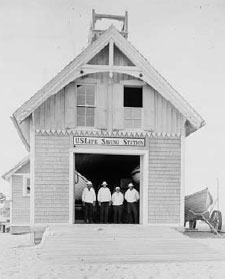
Kill Devil Hills Life-Saving Station, with four crew members. Photo attributed to Wilbur and/or Orville Wright, circa 1902. Life-Saving functions were placed under Treasury by Congress in 1837. The U.S. Life-Saving Service became a separate bureau of the Treasury Department in 1878. In 1915 the Life-Saving Service merged with the Revenue Cutter Service to become the U.S. Coast Guard. The Coast Guard transferred to the Department of Transportation in 1967.
(U.S. Coast Guard)
Treasury is an agency that has been sculpted by the history of the nation it serves, though its basic functions, assigned by Congress from powers granted to Congress in the Constitution, remain constant. The Department has adapted to the ever-changing realities of the nation's development through periodic innovations and reorganizations. The Civil War, for example, had a great effect upon the activities of the Department of the Treasury: the loss of customs revenues from the seceded Southern states resulted in the establishment of the Bureau of Internal Revenue, as well as the printing of paper currency and the institution of the National

This is the only photograph of the world's first flight in a power driven heavier than air machine, which was invented by Wilbur and Orville Wright. This picture was taken by Surfman J.T. Daniels, a member of the crew of the Kill Devil Hills Lifesavings Stations, December 17, 1903. Five Treasury employees were the first eyewitnesses to this historic flight. (Library of Congress)
Banking System. The growth of international trade after World War I and America's involvement in World War II demanded an active role by the Department of the Treasury in the Bretton Woods Conference in 1944, which established the International Monetary Fund and the World Bank, and the leadership of the United States in promoting worldwide economic development.

As the 52nd Secretary of the Treasury (1934-1945), Henry Morgenthau, Jr. served from the Depression through World War II. During his tenure as Secretary of the Treasury, he served as chairman of the conference at Bretton Woods (1944) which established the International Monetary Fund and the World Bank. (Treasury Collection)
